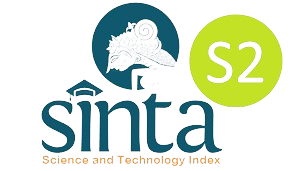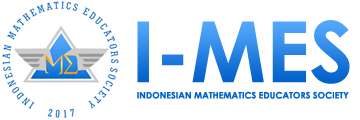Understanding mathematical concepts in students with borderline intellectual functioning: Insights from representational gestures
DOI:
https://doi.org/10.29408/jel.v11i4.31388Keywords:
representational gesture, slow learner, understanding of mathematical conceptsAbstract
When solving problems, the spontaneous actions of students identified as slow learners (SL) often reflect their cognitive limitations. This study analyzed students' SL understanding of mathematical concepts through representational gestures as a means of communication in constructing concepts. A qualitative case study was conducted in a public junior high school in Lamongan Regency. From eight SL students identified through IQ tests and teacher interviews, only three consistently used representational gestures and were selected as the subjects. Although limited, this sample enabled an in-depth analysis while acknowledging restricted generalization. Data were collected through functional tasks, gesture observations, and interviews and were then analyzed interactively through data reduction, display, and conclusion drawing. The results showed that SL students frequently used hand gestures to represent graph axes or intersection points but misinterpreted variable relationships. They could only classify objects based on conceptual conditions, while other indicators of understanding were not attained. These findings suggest that teachers should consider students’ gestures not only as spontaneous expressions but also as diagnostic cues for misconceptions and as a support for mathematical communication.
References
Afan, T. I., Wikan, W. B., & Wahyuningsih, E. D. (2021). Analisis kemampuan pemahaman matematis pada siswa slow learner [Analysis of mathematical comprehension abilities in slow learners]. Jurnal Inovasi Pendidikan Matematika (JIPM, 3(2), 92–105.
Alibali, M. W., & Nathan, M. J. (2007). Teachers’ gestures as a means of scaffolding students’ understanding: Evidence from an early algebra lesson. Video Research in the Learning Sciences, 349–365.
Alibali, M. W., & Nathan, M. J. (2012). Embodiment in mathematics teaching and learning: Evidence from learners’ and teachers’ gestures. Journal of the Learning Sciences, 21(2), 247–286.
Amir, N. T. (2013). Pendidikan anak berkebutuhan khusus lamban belajar slow learner [Education for children with special needs slow learners].
APA. (2013). Diagnostic and statistical manual of mental disorders (5th ed.). American Psychiatric Association.
Azzahra, N., & Herman, T. (2022). Cognitive ability characteristic and learning motivation on slow learners in solving mathematics problem. AIP Conference Proceedings, 2468, 070027.
Borah, R. R. (2013). Slow learners: Role os teachers and guardians in honing their hidden skills”. International Journal of Educational Planning & Administration, 3(2), 139–143. https://www.ripublication.com/ijepa/ijepav3n2_04.pdf
Chauhan, S. (2011). Slow learners: Their psychology and educational programmes. International Journal of Multidisciplinary Research, 1(8), 278–289. www.zenithresearch.org.in
Chen, H., Disney, L., & Li, L. (2025). Children’s mathematics concept learning of informal length measurement: Conceptual PlayWorld as an innovative approach in the beginning of primary school period. Journal of Mathematical Behavior, 79(April), 101257. https://doi.org/10.1016/j.jmathb.2025.101257
Cook, S. W., & Goldin-Meadow, S. (2006). The role of gesture in learning: Do children use their hands to change their minds? Journal of Cognition and Development, 7(2), 211–232.
Creswell, J. W., & Creswell, J. D. (2018). Research design qualitative, quantitative, and mixed methods approaches.
Dirusso, A. A. (1999). The function of gesture in learning to count: More than keeping track. Cognitive Development, 56(7 999), 37–56.
Elvierayani, R. R., & Kholiq, A. (2019). Gesture siswa tunagrahita dalam menyelesaikan masalah matematika Gestures of students with intellectual disabilities in solving math problems]. Lintang Songo: Jurnal Pendidikan, 2(2), 38–51. https://doi.org/https://journal.unusida.ac.id/index.php/jls/article/download/294/241
Elvierayani, R. R., Sa'dijah, C., Sukoriyanto, R., & R. (2023). Counterproductive gesture: The thinking process of slow learners in solving integer operations problems. Journal for ReAttach Therapy and Developmental Diversities, 6(1), 237–247.
Elvierayani, R. R., Sa'dijah, C., Sukoriyanto, R., R, & Mustakim, S. S. (2025). Collaborative gestures of slow learner students in group discussions for solving mathematical problems. AIP Conference Proceedings, 3142(1). https://doi.org/10.1063/5.0262522
Faisal, N., Usman, M., Pirzada, P., & Hassan, A. (2016). Innovating e-learning concepts in special education by gesture recognition using kinect. 44–50.
Francaviglia, M., & Servidio, R. (2011). Gesture as a Cognitive Support to Solve Mathematical Problems. Psychology, 02(02), 91–97. https://doi.org/10.4236/psych.2011.22015
Gashaj, V., Thaqi, Q., Mast, F. W., & Roebers, C. M. (2023). Foundations for future math achievement: Early numeracy, home learning environment, and the absence of math anxiety. Trends in Neuroscience and Education, 33, 100217. https://doi.org/10.1016/j.tine.2023.100217
Goldin-Meadow, S. (2003). Hearing gesture: How our hands help us think. Belknap Press of Harvard University Press.
Goldin-Meadow, S. (2015). From action to abstraction: Gesture as a mechanism of change. Developmental Review, 38, 167–184.
Gunawan, E., Hidayanto, E., & Rahardi, R. (2021). Profil pointing dan representational gesture siswa dalam menyelesaikan soal matematika materi fungsi linear [Students' pointing and representational gestures in solving linear function math problems. Jurnal Pendidikan: Teori, Penelitian, dan Pengembangan, 6(3), 459.
Heward, W. L. (2013). Exceptional children: An introduction to special education (10th ed.). Pearson.
Hord, C., Marita, S., Walsh, J., Tomaro, T. M., Gordon, K., & Saldanha, R. (2016). Teacher and student use of gesture and access to secondary mathematics for students with learning disabilities: An exploratory study. Learning Disabilities: A Contemporary Journal, 14(2), 189–206.
Hostetter, A. B., & Alibali, M. W. (2008). Visible embodiment : Gestures as simulated action Visible embodiment : Gestures as simulated action. Psychonomic Bulletin & Review, 15(3), 495–514.
Listiawati, N., Sabon, S. S., Siswantari, S., Wibowo, S., Zulkardi, & Riyanto, B. (2023). Analysis of implementing realistic mathematics education principles to enhance mathematics competence of slow learner students. Journal on Mathematics Education, 14(4), 683–700.
McNeill, D. (1992). Hand and mind: What gesture reveal about thought. Chicago University Press.
Miles, M. B., Huberman, A. M., & Saldaña, J. (2014). Qualitative data analysis: A methods sourcebook (3rd ed.). Sage.
Mullis, I. V. S., Martin, M. O., Foy, P., Kelly, D. L., & Fishbein, B. (2023). TIMSS 2023 international results in mathematics and science. TIMSS & PIRLS International Study Center.
OECD. (2014). PISA 2012 results: What students know and can do (Volume I. OECD Publishing.
Oktavianita, S., & Wahidin, W. (2022). Gestur siswa slow learner dalam belajar matematika menggunakan aplikasi wordwall di sekolah dasar [Gestures of slow learners in learning mathematics using the Wordwall application in elementary school]. Jurnal Basicedu, 6(3), 4802–4811.
Pier, E. L., Walkington, C., Clinton, V., Boncoddo, R., Williams-Pierce, C., Alibali, M. W., & Nathan, M. J. (2019). Embodied truths: How dynamic gestures and speech contribute to mathematical proof practices. Contemporary Educational Psychology, 58, 44–57. https://doi.org/10.1016/j.cedpsych.2019.01.012
Radford, L., Edwards, L., & Arzarello, F. (2009). Introduction: Beyond words. Educational Studies in Mathematics, 70(2), 91–95.
Ramadani, M., & Khayroiyah, S. (2021). Analisis pemahaman konsep matematis dan gestur pembelajaran lamban (slow learning) pada materi pecahan di MTs. Raudhatul Hasanah [Analysis of mathematical concept understanding and slow learning gestures on fractions in MTs Raudhatul Hasanah]. MathEducation Nusantara, 4(2), 108–114.
Ridha, A. A., & Nurdibyanandaru, D. (2018). Effectiveness of keyword mnemonic strategies to increase the math vocabulary of slow learner students. International Journal of Indian Psychology, 6(4).
Root, J. R. (2019). Effects of explicit instruction on acquisition and generalization of mathematical concepts for a student with autism spectrum disorder. Research in Autism Spectrum Disorders, 57(October), 1–6.
Shaw, S. (2010). Rescuing students from the slow learner trap. Principal Leadership, 12–16. https://doi.org/http://www.eric.ed.gov/ERICWebPortal/recordDetail?accno=EJ894654
Skemp, R. (1978). Relational understanding and instrumental understanding. The Arithmetic Teacher, 26(3), 9–15.
Sovia, A., & Herman, T. (2020). Gesture of slow learner student in mathematical Communication. Journal of Physics: Conference Series, 1464(1). https://doi.org/10.1088/1742-6596/1464/1/012046
Susanto, A. (2014). Teori belajar dan pembelajaran di sekolah dasar [Theories of learning and teaching in elementary schools]. Kencana.
Wafiqoh, R., Maulana, S. A., & Pramuditya, S. A. (2022). Mathematics learning difficulties of slow learner students in terms of reflective abstraction measurement. AKSIOMA: Jurnal Program Studi Pendidikan Matematika, 11(2), 1052–1062.
Walsh, J. B., & Hord, C. (2019). Using gestures and diagrams to support students with learning disabilities enrolled in Algebra II. Learning Disabilities: A Contemporary Journal, 17(1), 59–75.
Wanabuliandari, S., Wardono, S., E, B., Bintoro, H. S., & Mariani, S. (2025). A systematic literature review on slow learners’ problem-solving in mathematics education. International Journal of Learning, Teaching and Educational Research, 24(3), 699–724.
Wilson, M. (2002). Six views of embodied cognition. Psychometric Bulletin & Review, 9(4), 625–636.
Yimam, M., & Dagnew Kelkay, A. (2022). Evaluation of the effects of discourse-based mathematics instruction on eleventh grade students’ conceptual and procedural understanding of probability and statistics. Cogent Education, 9(1). https://doi.org/10.1080/2331186X.2021.2007742
Yunuka. (2016). Pemahaman konsep [Concept understanding]. Jurnal Kimia Informasi dan Pemodelan, 53(9), 1689–1699.
Zhang, Y., Zhang, X., & Meng, Z. (2024). Effect of interactive immediacy on online learning satisfaction of international students in Chinese universities: The chain mediating role of learning interest and academic engagement. Acta Psychologica, 244(97), 104202. https://doi.org/10.1016/j.actpsy.2024.104202
Downloads
Published
How to Cite
Issue
Section
License
Copyright (c) 2025 Rivatul Ridho Elvierayani, Restu Lusiana, Beti Istanti Suwandayani, Ifroha Anita Silvia

This work is licensed under a Creative Commons Attribution-ShareAlike 4.0 International License.
Authors who publish with the Jurnal Elemen agree to the following terms:
- Authors retain copyright and grant the journal right of first publication with the work simultaneously licensed under Creative Commons Attribution-ShareAlike 4.0 International License (CC BY-SA 4.0).
- Authors are able to enter into separate, additional contractual arrangements for the distribution of the journal's published version of the work (e.g., post it to an institutional repository or publish it in a book), with an acknowledgment of its initial publication in this journal.
- Authors are permitted and encouraged to post their work online (e.g., in institutional repositories or on their website) prior to and during the submission process, as it can lead to productive exchanges, as well as earlier and greater citation of published work.
Jurnal Elemen is licensed under a Creative Commons Attribution-ShareAlike 4.0 International License





